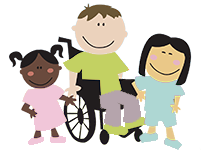[vc_row][vc_column][vc_column_text]Dyspraxia is defined as a childhood developmental disorder that’s marked by clumsiness in children who are otherwise healthy. Some of the most common symptoms include delays in sitting or walking. Many children with dyspraxia find it difficult to jump or do “simple” tasks like tying their own shoelaces. This becomes particularly problematic when a child reaches school age.
Why Dyspraxia is Problematic in Schools
 Although dyspraxia isn’t considered a specific type of learning disability, it is a disability that can impact how a child learns. This is because dyspraxia is a pervasive developmental disorder that’s sometimes referred to as a “motor learning disability.” As such, it will have several different effects on a child when they’re in your classroom – including coordination, moving about, language, speech, and overall learning. Since this can be very distressing to a child, it also makes children prone to have temper tantrums. The exact opposite is also true in that these children can be very highly excited without much prompting and when this happens, they’ll react with a loud, shrill voice.
Although dyspraxia isn’t considered a specific type of learning disability, it is a disability that can impact how a child learns. This is because dyspraxia is a pervasive developmental disorder that’s sometimes referred to as a “motor learning disability.” As such, it will have several different effects on a child when they’re in your classroom – including coordination, moving about, language, speech, and overall learning. Since this can be very distressing to a child, it also makes children prone to have temper tantrums. The exact opposite is also true in that these children can be very highly excited without much prompting and when this happens, they’ll react with a loud, shrill voice.
Setting up an “Appropriate Learning Environment” for Children with Dyspraxia
Teaching children who have dyspraxia can be frustrating because these children typically display a wide range of symptoms. However, these children are really intelligent – having no disabilities that prevent them from learning alongside their peers as long as they’re occasionally given extra attention and support. There are a few things that a teacher can do to help these students, including:
- Teachers should provide wide-stemmed pencils and pens with rubber grips and graph paper so it’s easier for the child to write and make sure their writing is properly spaced too.
- Activities other than handwriting should be provided – including having a friend take notes for them, computers, electronic copies of materials provided ahead of time, teaching touch typing, and matching exercises for testing comprehension.
- You should place these students in the front of the room so it’s easier for them to see the board and concentrate.
- Breaks that allow the student to get up and move about will help them be able to concentrate better.
- Never pressure these students to process things as fast as other students as it will take them a little extra time to do things like move between classrooms.
There are a lot of things teachers can do to help students who have dyspraxia. Above all else, it’s important to understand these students are just as intelligent as the rest of your class as long as you provide some small but appropriate learning supports.[/vc_column_text][/vc_column][/vc_row]
